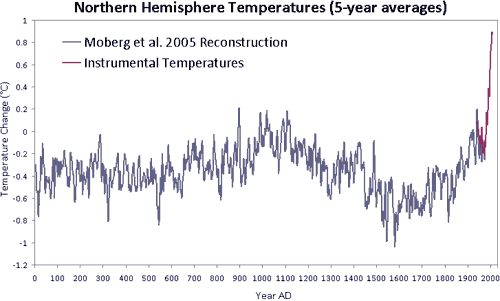Climate Change - The Medieval Warm Period and The Little Ice Age
Why can’t recent climate change just be an effect of 'natural causes'?
There have been climate changes in the past 2000 years.
People talk about times called the Medieval Warm Period and the Little Ice Age.
Careful research has shown that the current temperature is warmer than the Medieval Warm Period - temperatures between 1000 and 1100 AD were probably similar to the late 20th century, but 21st century temperatures are already warmer.

The Medieval Warm Period may not even have been a global event - glaciers on Baffin Island were no smaller during that time.
A particularly cool period is often called the Little Ice Age.
However, the name "Little Ice Age" is now regarded as misleading.
The best estimate of the drop in temperature is, at most, 0.5°C, compared to the temperature decreases in "real" ice ages of about 8°C.
Also, the "Little Ice Age" only lasted for 500 years at most, compared to the 20,000 years of the last ice age.
The start of that period is associated with the major volcanic eruption in 1257 of the Samalas volcano, next to Mount Rinjani on the island of Lombok, Indonesia.

This eruption was followed by famines in many places.
In 1258, a monk in England reported: "The north wind prevailed for several months… scarcely a small rare flower or shooting germ appeared, whence the hope of harvest was uncertain... Innumerable multitudes of poor people died, and their bodies were found lying all about swollen from want…
The lowest temperatures in the LIA, between about 1570 and 1730, were during a period of almost continuous volcanic activity.
The Industrial Revolution, when coal burning began on a large scale, started the recent rise in temperatures, reversing the cooling trend.
There have been climate changes in the past 2000 years.
People talk about times called the Medieval Warm Period and the Little Ice Age.
Careful research has shown that the current temperature is warmer than the Medieval Warm Period - temperatures between 1000 and 1100 AD were probably similar to the late 20th century, but 21st century temperatures are already warmer.

The Medieval Warm Period may not even have been a global event - glaciers on Baffin Island were no smaller during that time.
A particularly cool period is often called the Little Ice Age.
However, the name "Little Ice Age" is now regarded as misleading.
The best estimate of the drop in temperature is, at most, 0.5°C, compared to the temperature decreases in "real" ice ages of about 8°C.
Also, the "Little Ice Age" only lasted for 500 years at most, compared to the 20,000 years of the last ice age.
The start of that period is associated with the major volcanic eruption in 1257 of the Samalas volcano, next to Mount Rinjani on the island of Lombok, Indonesia.

This eruption was followed by famines in many places.
In 1258, a monk in England reported: "The north wind prevailed for several months… scarcely a small rare flower or shooting germ appeared, whence the hope of harvest was uncertain... Innumerable multitudes of poor people died, and their bodies were found lying all about swollen from want…
The lowest temperatures in the LIA, between about 1570 and 1730, were during a period of almost continuous volcanic activity.
The Industrial Revolution, when coal burning began on a large scale, started the recent rise in temperatures, reversing the cooling trend.